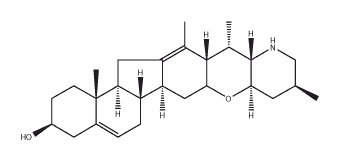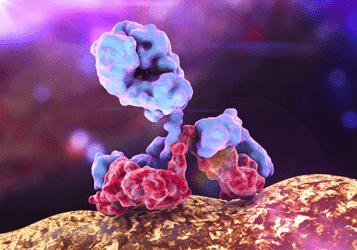- Home
- Products
- DrugLnk™ Linker-Payloads
- ADC Toxins
- Cyclopamine, Free Base
Cyclopamine, Free Base (CAT#: ADC-P-079)
ADCs Toxins, Cyclopamine is a Hedgehog signaling pathway inhibitor. Cyclopamine inhibits the growth of medulloblastoma cells. Activation of the hedgehog (HH) pathway plays a critical role in the development and continued growth of pancreatic adenocarcinoma (PAC). Cyclopamine, a HH pathway inhibitor, has been shown to suppress PAC cell proliferation in vitro and in vivo. However, the molecular basis of response to cyclopamine has not been fully elucidated nor have genes that predict sensitivity to this compound been identified. The viability of 9 human PAC cell lines following cyclopamine exposure was determined using MTS assay. Among the cell lines examined, cyclopamine IC50 values ranged from 8.79 to >30 µM. Response to cyclopamine included reduced cell proliferation and induction of apoptosis with and without mitochondrial membrane depolarization. Regression analysis revealed that GLI3 expression significantly correlated with cyclopamine resistance (r = 0.80; p = 0.0102). Knockdown of GLI3 using siRNAs increased sensitivity to cyclopamine. In addition, GLI3 siRNAs decreased PAC cell viability and reduced expression of genes involved in HH signaling (Patched 1 and GLI1) and cell proliferation, similar to cyclopamine. These effects were not observed in PAC cells with undetectable GLI3 expression. These data suggest that Gli3 mediates cell survival and sensitivity to cyclopamine in pancreatic cancer. (Partially: Cancer Biol Ther. 2010 Nov 1;10(9):893-902. doi: 10.4161/cbt.10.9.13252. Epub 2010 Nov 1.).
- Product Information
- CAS NO
- 4449-51-8
- Description
- ADCs Toxins, Cyclopamine is a Hedgehog signaling pathway inhibitor. Cyclopamine inhibits the growth of medulloblastoma cells. Activation of the hedgehog (HH) pathway plays a critical role in the development and continued growth of pancreatic adenocarcinoma (PAC). Cyclopamine, a HH pathway inhibitor, has been shown to suppress PAC cell proliferation in vitro and in vivo. However, the molecular basis of response to cyclopamine has not been fully elucidated nor have genes that predict sensitivity to this compound been identified. The viability of 9 human PAC cell lines following cyclopamine exposure was determined using MTS assay. Among the cell lines examined, cyclopamine IC50 values ranged from 8.79 to >30 µM. Response to cyclopamine included reduced cell proliferation and induction of apoptosis with and without mitochondrial membrane depolarization. Regression analysis revealed that GLI3 expression significantly correlated with cyclopamine resistance (r = 0.80; p = 0.0102). Knockdown of GLI3 using siRNAs increased sensitivity to cyclopamine. In addition, GLI3 siRNAs decreased PAC cell viability and reduced expression of genes involved in HH signaling (Patched 1 and GLI1) and cell proliferation, similar to cyclopamine. These effects were not observed in PAC cells with undetectable GLI3 expression. These data suggest that Gli3 mediates cell survival and sensitivity to cyclopamine in pancreatic cancer. (Partially: Cancer Biol Ther. 2010 Nov 1;10(9):893-902. doi: 10.4161/cbt.10.9.13252. Epub 2010 Nov 1.).
- Classification
- Others
- Molecular Weight
- 411.62
- Purity
- 95%

For Research Use Only. NOT FOR CLINICAL USE.
Related Products
- Triptolide (CAT#: ADC-P-029)
- Tubulysin IM-2 (CAT#: ADC-P-041)
- DM4 (CAT#: ADC-P-034)
- Chaetoglobosin C13 (unlabeled) (CAT#: ADC-P-069)
- Muscotoxin A (CAT#: ADC-P-114)
- Duocarmycin SA (CAT#: ADC-P-043)
- Duocarmycin DM (CAT#: ADC-P-046)
- Boc-Nme-Val-Val-Dil-Dap-OH (CAT#: ADC-P-039)
- Duocarmycin MA (CAT#: ADC-P-045)
- Puwainaphycin F (CAT#: ADC-P-131)
Published Data
+ Submit Publications

Scientific Resources
Customer Reviews and FAQs
There are currently no Customer reviews or questions for ADC-P-079. Click the button above to contact us or submit your feedback about this product.
Quick Links
Online Inquiry
Welcome! For price inquiries, please feel free to contact us through the form on the left side. We will get back to you as soon as possible.



